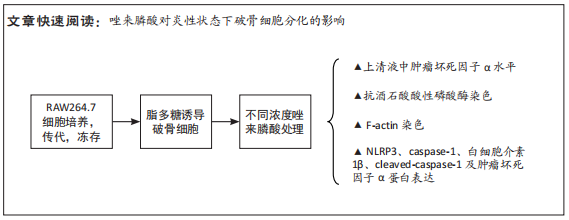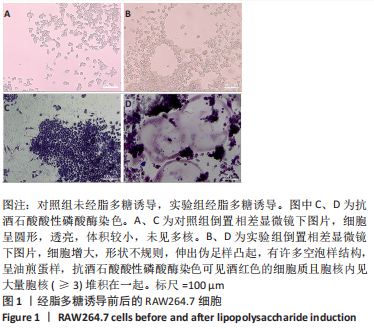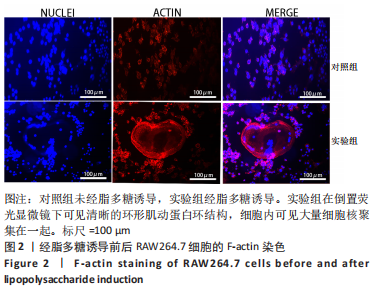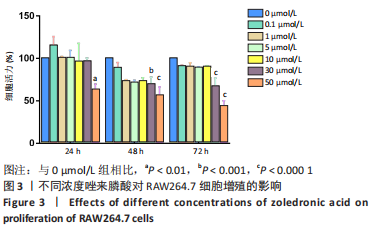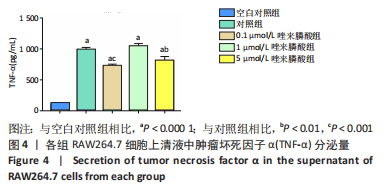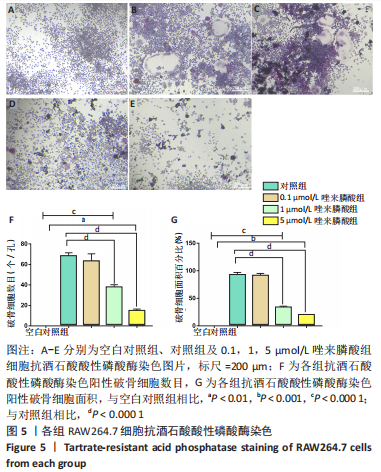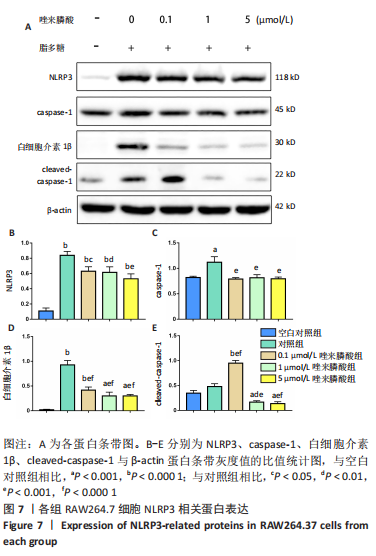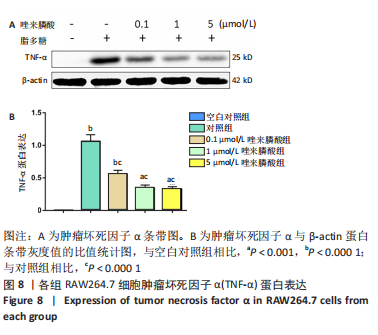[1] TANAKA S, TANAKA Y, ISHIGURO N, et al. RANKL: A therapeutic target for bone destruction in rheumatoid arthritis. Mod Rheumatol. 2018; 28(1):9-16.
[2] 王艺睿,王会,戚孟春,等.钙调蛋白依赖性激酶Ⅱγ RNA干扰载体构建及对破骨细胞分化和骨吸收的影响[J].实用医学杂志, 2019,35(4):557-561.
[3] NAIR SP, MEGHJI S, WILSON M, et al. Bacterially induced bone destruction: mechanisms and misconceptions. Infect Immun. 1996; 64(7):2371-2380.
[4] 刘子歌,张晨,宋国瑞,等.白藜芦醇对LPS刺激下RAW264.7细胞向破骨细胞分化的影响[J].医学研究杂志,2020,49(9):27-31.
[5] IVANOV K, GARANINA E, RIZVANOV A, et al. Inflammasomes as Targets for Adjuvants. Pathogens. 2020;9(4):252.
[6] 张坦,王茹,丁树哲.糖脂代谢参与NLRP3炎症小体活化的研究进展[J].生命科学,2022,34(4):385-391.
[7] REN H, KONG Y, LIU Z, et al. Selective NLRP3 (Pyrin Domain-Containing Protein 3) Inflammasome Inhibitor Reduces Brain Injury After Intracerebral Hemorrhage. Stroke. 2018;49(1):184-192.
[8] VAN OPDENBOSCH N, LAMKANFI M. Caspases in Cell Death, Inflammation, and Disease. Immunity. 2019;50(6):1352-1364.
[9] PARK S, SHIN J, BAE J, et al. SIRT1 Alleviates LPS-Induced IL-1β Production by Suppressing NLRP3 Inflammasome Activation and ROS Production in Trophoblasts. Cells. 2020;9(3):728.
[10] YARILINA A, XU K, CHEN J, et al. TNF activates calcium-nuclear factor of activated T cells (NFAT)c1 signaling pathways in human macrophages. Proc Natl Acad Sci U S A. 2011;108(4):1573-1578.
[11] DENG S, DAI G, CHEN S, et al. Dexamethasone induces osteoblast apoptosis through ROS-PI3K/AKT/GSK3β signaling pathway. Biomed Pharmacother. 2019;110:602-608.
[12] LIN CN, DING SJ, CHEN CC. Synergistic Photoantimicrobial Chemotherapy of Methylene Blue-Encapsulated Chitosan on Biofilm-Contaminated Titanium. Pharmaceuticals (Basel). 2021;14(4):728.
[13] 刘奇奇,刘敏,杨健,等.脂多糖刺激小鼠MLO-Y4骨细胞白细胞介素6及核因子κB受体活化因子配体的表达[J].中国组织工程研究,2022,26(30):3121-3126.
[14] KITAURA H, MARAHLEH A, OHORI F, et al. Osteocyte-Related Cytokines Regulate Osteoclast Formation and Bone Resorption. Int J Mol Sci. 2020;21(14):5169.
[15] ALQRANEI MS, CHELLAIAH MA. Osteoclastogenesis in periodontal diseases: Possible mediators and mechanisms. J Oral Biosci. 2020;62(2): 123-130.
[16] 曾立,徐永明,邢更彦.脂多糖对破骨细胞生成及骨吸收功能作用及其机制研究[J].中国修复重建外科杂志,2018,32(5):568-574.
[17] ISLAM S, HASSAN F, TUMURKHUU G, et al. Bacterial lipopolysaccharide induces osteoclast formation in RAW 264.7 macrophage cells. Biochem Biophys Res Commun. 2007;360(2):346-351.
[18] 高爱超,于海燕,李娜,等.牙龈卟啉单胞菌脂多糖(Pg-LPS)对破骨细胞EphA2基因表达的调控[J]. 口腔医学研究,2015,31(3):268-271+275.
[19] ONO T, NAKASHIMA T. Recent advances in osteoclast biology. Histochem Cell Biol. 2018;149(4):325-341.
[20] COLLIN-OSDOBY P, OSDOBY P. RANKL-mediated osteoclast formation from murine RAW 264.7 cells. Methods Mol Biol. 2012;816:187-202.
[21] CHEN JS, SAMBROOK PN. Antiresorptive therapies for osteoporosis: a clinical overview. Nat Rev Endocrinol. 2011;8(2):81-91.
[22] DRAKE MT, CLARKE BL, KHOSLA S. Bisphosphonates: mechanism of action and role in clinical practice. Mayo Clin Proc. 2008;83(9): 1032-1045.
[23] BOWDEN SA, MAHAN JD. Zoledronic acid in pediatric metabolic bone disorders. Transl Pediatr. 2017;6(4):256-268.
[24] DHILLON S. Zoledronic Acid (Reclast(®), Aclasta(®)): A Review in Osteoporosis. Drugs. 2016;76(17):1683-1697.
[25] 黄晓林,廖健,洪伟,等.破骨细胞形成过程中唑来膦酸的作用途径及机制[J].中国组织工程研究,2019,23(17):2716-2721.
[26] HUANG XL, HUANG LY, CHENG YT, et al. Zoledronic acid inhibits osteoclast differentiation and function through the regulation of NF-κB and JNK signalling pathways. Int J Mol Med. 2019;44(2):582-592.
[27] HAYMAN AR. Tartrate-resistant acid phosphatase (TRAP) and the osteoclast/immune cell dichotomy. Autoimmunity. 2008;41(3): 218-223.
[28] MINKIN C. Bone acid phosphatase: tartrate-resistant acid phosphatase as a marker of osteoclast function. Calcif Tissue Int. 1982;34(3): 285-290.
[29] TEVLIN R, MCARDLE A, CHAN CK, et al. Osteoclast derivation from mouse bone marrow. J Vis Exp. 2014;(93):e52056.
[30] NABAVI N, KHANDANI A, CAMIRAND A, et al. Effects of microgravity on osteoclast bone resorption and osteoblast cytoskeletal organization and adhesion. Bone. 2011;49(5):965-974.
[31] TEITELBAUM SL. The osteoclast and its unique cytoskeleton. Ann N Y Acad Sci. 2011;1240:14-17.
[32] MATSUBARA T, KINBARA M, MAEDA T, et al. Regulation of osteoclast differentiation and actin ring formation by the cytolinker protein plectin. Biochem Biophys Res Commun. 2017;489(4):472-476.
[33] KODAMA J, KAITO T. Osteoclast Multinucleation: Review of Current Literature. Int J Mol Sci. 2020;21(16):5685.
[34] CHO YA, JUE SS, BAE WJ, et al. PIN1 inhibition suppresses osteoclast differentiation and inflammatory responses. J Dent Res. 2015;94(2): 371-380.
[35] 任莉荣,王海,何晓清,等.金葡菌脂磷壁酸促进破骨细胞分化的分子机制[J].实用医学杂志,2016,32(20):3369-3372.
[36] ZHANG Y, YAN M, YU Q F, et al. Puerarin Prevents LPS-Induced Osteoclast Formation and Bone Loss via Inhibition of Akt Activation. Biol Pharm Bull. 2016;39(12):2028-2035.
[37] GHAYOR C, GJOKSI B, SIEGENTHALER B, et al. N-methyl pyrrolidone (NMP) inhibits lipopolysaccharide-induced inflammation by suppressing NF-κB signaling. Inflamm Res. 2015;64(7):527-536.
[38] HOTOKEZAKA H, SAKAI E, OHARA N, et al. Molecular analysis of RANKL-independent cell fusion of osteoclast-like cells induced by TNF-alpha, lipopolysaccharide, or peptidoglycan. J Cell Biochem. 2007;101(1): 122-134.
[39] ALQRANEI MS, SENBANJO LT, ALJOHANI H, et al. Lipopolysaccharide- TLR-4 Axis regulates Osteoclastogenesis independent of RANKL/RANK signaling. BMC Immunol. 2021;22(1):23.
[40] JIANG N, AN J, YANG K, et al. NLRP3 Inflammasome: A New Target for Prevention and Control of Osteoporosis? Front Endocrinol (Lausanne). 2021;12:752546.
[41] 陆佳伟,刘效谷,张文波.LncRNA及miRNA对NLRP3炎症小体信号的调控机制及其在相关疾病中的意义[J].实用医学杂志,2020, 36(22):3149-3152.
[42] MOOSSAVI M, PARSAMANESH N, BAHRAMI A, et al. Role of the NLRP3 inflammasome in cancer. Mol Cancer. 2018;17(1):158.
[43] CHEN Y, YANG Q, LV C, et al. NLRP3 regulates alveolar bone loss in ligature-induced periodontitis by promoting osteoclastic differentiation. Cell Prolif. 2021;54(2):e12973.
[44] DETZEN L, CHEAT B, BESBES A, et al. NLRP3 is involved in long bone edification and the maturation of osteogenic cells. J Cell Physiol. 2021;236(6):4455-4469.
[45] ZANG Y, SONG JH, OH SH, et al. Targeting NLRP3 Inflammasome Reduces Age-Related Experimental Alveolar Bone Loss. J Dent Res. 2020;99(11):1287-1295.
[46] RUSCITTI P, CIPRIANI P, CARUBBI F, et al. The role of IL-1β in the bone loss during rheumatic diseases. Mediators Inflamm. 2015;2015: 782382.
[47] KAWAHARA Y, KANEKO T, YOSHINAGA Y, et al. Effects of Sulfonylureas on Periodontopathic Bacteria-Induced Inflammation. J Dent Res. 2020;99(7):830-838.
[48] 党万太,谢文光,赵明才,等.痛风性关节炎患者NLRP3炎性体基因转录剪接体mRNA表达与临床检测指标的相关分析[J].第三军医大学学报,2014,36(16):1713-1719.
[49] 史纪元,姬乐,武世勋,等.淫羊藿苷通过抑制NLRP3炎性小体和Caspase-1通路减轻骨关节炎[J]. 世界中医药,2021,16(18):2706-2713.
|
